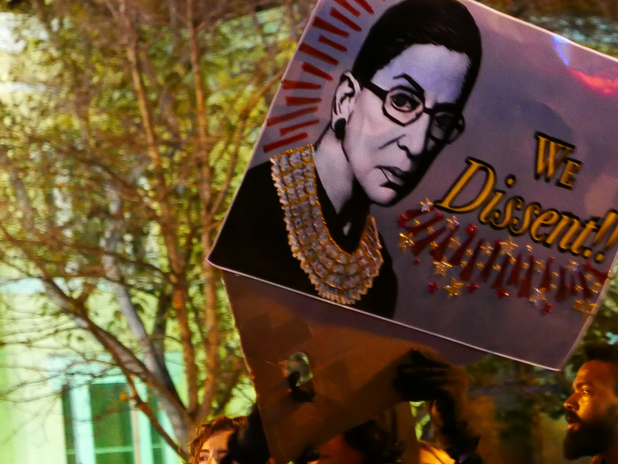On September 18, United States Supreme Court Justice Ruth Bader Ginsberg passed away due to complications from pancreatic cancer. Born in 1933, Ginsberg came of age in a time where the professional world belonged to men; as a woman in that world, she navigated through inherent challenges and setbacks with grit and grace, cleverly forging societal change by situating herself in spaces where her intelligence, perspective, and resilience translated into power. Her life’s work reconstituted what it means to be a woman in the US, and her legacy lives in the aspirations and activism of today’s young feminists.
In the 1960s and 70s, Ginsberg pioneered the field of gender discrimination law and revolutionized women’s rights in the US. She embodied a pragmatic feminism as an academic and litigator, systematically challenging hundreds of federal and state laws that upheld archaic sex-based stereotypes. Ginsberg won five monumental Supreme Court cases which expanded the constitutional right to equal protection under the law to women, persuading the court that laws treating men and women differently, including laws designed to protect or benefit women, are both oppressive and unconstitutional. “A gender line…”, Ginsberg argued, “helps not to keep women on a pedestal but in a cage.”
Ginsberg’s dismantlement of the legislative cage that kept generations of American women out of high places earned her a formidable reputation as one of the top legal minds in the country; the bars that once functioned as a barrier to her success became the rungs she climbed to reach the very top of her field. In 1980, Ginsberg became a federal appellate judge, and in 1993, she was appointed by President Clinton to serve as the second female Supreme Court justice in history.
Ginsberg approached the Constitution as a living document to be understood within the context of the present moment. From her seat on the highest court, Ginsberg defended the rights of women, individuals with disabilities, and immigrants, and she voted in the majority on the 2015 landmark case Obergefell v. Hodges, which extended marital rights to same-sex couples. “I hope people will think of me as a good judge,” said Ginsberg, “who tried with whatever ability I have to interpret the law wisely and to keep it in tune with the people the law exists, or should exist, to serve.”
Ginsberg understood that justice is best maintained by a unified court, and she operated as a moderate influence in her early years on the bench. However, in the latter years of her Supreme Court tenure, the appointment of several conservative justices shifted the court’s ideological balance. Ginsberg became the mainstay of the liberal minority, and in that role, she found power in dissent.
Ginsberg defended her opinions with sharp intellect and undeniable flair, authoring dissenting statements that launched her into unlikely stardom. The petite, soft-spoken, rule abiding jurist in her 80s became the larger-than-life “Notorious RBG”.
“I dissent” resonated as a feminist rally cry, sending a message to Ginsberg’s youthful fanbase to remain unsatisfied, to question power, and to stand up for one’s rights and liberties. Dissent, as Ginsberg modeled, can be a pathway to lasting social change, but what do we stand to learn from Ginsberg’s dissents about how we should actually represent dissatisfaction and approach conflict constructively?
Ginsberg saw dissent as a fundamental function of the Supreme Court, serving as a sort of internal check and balance for the Judicial Branch. A strong dissenting argument forces the opposing majority to refine their position which ensures that there are no gaps in the court’s justification for its final ruling. The strongest opinions, she believed, are formulated like a dialog, with arguments on each side enhanced by listening to and learning from the ideas and interpretations of the other.
Ginsberg also recognized that dissent is an instrument of hope; when she dissented, she communicated to those that shared her opinion that their pursuit of justice should not be abandoned. Dissenting arguments can be built upon by future lawyers to rechallenge the ruling made by the court’s majority. Ginsberg said, “Justices continue to think and change. I am ever hopeful that if the court has a blind spot today, its eyes will be open tomorrow.”
On occasion, a judicial dissent will spark an immediate response outside the court. In the case of Ledbetter v. Goodyear Tire & Rubber Co., the court agreed that Lily Ledbetter was paid an unequal salary by her long-term employer, Goodyear, because of her sex but ruled Ledbetter’s suit invalid because she didn’t make her claim soon enough. Ginsberg’s compelling dissent exposed a harmful ambiguity in the law, prompting congress to pass an amendment that clearly outlawed the type of pay discrimination the Ledbetter faced.
While Ginsberg’s dissents were often hypercritical of the majority’s logic, they didn’t threaten the working relationship between justices on the court; respect for the judicial process and for fellow justices allows for cordial and constructive disagreement. Ginsberg and her conservative colleague Justice Antonin Scalia were regular opponents on the bench but shared an odd-couple friendship in their personal lives. Their relationship is a reminder that ideological opposition is not always an irredeemable quality. “What’s not to like” Scalia joked fondly of Ginsberg, “except her views on the law.”
Ginsberg’s dissents did not have control over the court decisions, but her arguments were nevertheless intended to have lasting and significant outcomes. She argued to educate her peers on a different way of seeing an issue, and she hoped to inspire and inform future pursuits of justice. She did not, however, seek to isolate or belittle her opposition; she searched for middle ground.
These lessons from Ginsberg’s dissents are guiding in a time where conflict feels constant and common ground feels rare, where dinner table discussions and presidential debates devolve into ugly disputes, and where it’s easy to think we’re right because it’s so hard to sympathize with people we think are wrong. Defending a controversial opinion can feel like an exercise in futility, but Ginsberg reminds us that if we speak with conviction and remain civil in our approach to conflict, we will be heard. She reminds us to listen to our opposition with compassion and composure, seeking to learn and grow from what they have to offer. A good dissenter will be empowered by her position as a contender, knowing that she, like Ginsberg, has the capability to create enduring change.



